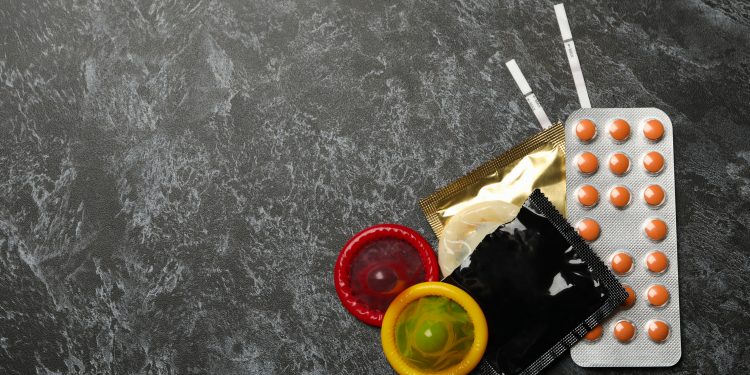A major crisis that the world is facing right now is population explosion. By 2050, the population of the world might reach 9.7 billion. The consequence of the Population explosion is the decline of material and financial resources. As a result, it poses a significant threat to the well-being of future generations. A simple solution is to create awareness of the importance of using male and female contraceptives and encourage them to use them. Sexual relations involve the consent of both man and woman. Therefore, both should play a role in making contraceptive decisions too. There are many alternatives to choose from, depending on the individual’s lifestyle and preference.
Male Contraceptives
Male contraceptives (also known as male birth control) are relatively cheaper, accessible, and do not cause significant side effects to the body. The following are some of the most common male contraceptives.
-
Condoms
Condoms are the most commonly used contraceptives. Popular materials used for making condoms are latex or polyurethane. A condom works like a physical barrier that prevents the sperm from reaching the vaginal area. When used correctly, condoms can prevent pregnancy by 98%. Condoms also help prevent the spread of Sexually Transmitted Diseases like HIV/AIDS, Gonorrhea, and Chlamydia.
-
Vasectomy
Vasectomy is a simple surgery where a surgeon cuts off and blocks the tube that carries the sperms from the testicles to the penis. This tube is called the vas deferens. Unfortunately, this contraceptive method is permanent, which means a reversal is not easily possible. Nevertheless, a vasectomy is close to 99% effective in avoiding pregnancy.
-
Spermicides
Spermicide is a type of chemical that kills sperms before they enter the vagina. After sexual intercourse, one of the partners can apply spermicides around the vaginal area to prevent the sperm from fertilizing the egg, thus avoiding pregnancy. Although it is an effective barrier method, continuous use can cause vaginal irritation.
-
Withdrawal method
Also called the “pulling out” method, the withdrawal method involves removing the penis from the vagina before ejaculation. The withdrawal method was in use long before for a very long time. However, this method is the least effective of all barrier methods. Nevertheless, it is effective when done right.
With the advancement in medical sciences, researchers are trying to develop a male contraceptive pill. This pill aims to lower the hormone testosterone- consequently reducing sperm production. However, this pill is still in its trial stages.
Female Contraceptives
Females have a lot more contraceptive options to choose from than males. However, they are more expensive and can cause hormonal and bodily changes to a woman’s body. The following female contraceptives include physical barriers and pharmaceutical methods.
-
Female Condom
A female condom (also called a femidom) has two rings attached to either side. Unlike a male condom, female condoms are not commonly available. But like a male condom, they also prevent transmission of Sexually Transmitted Diseases. It is effective 95% of the time.
-
Diaphragm
A diaphragm is a cap-like, silicone-made structure. A woman can insert it inside the vagina to block the entrance of the uterus. It has to be put in 24 hours before having sex, and the female should remove it immediately afterward. The success rate of avoiding pregnancies using a diaphragm is close to 99%.
-
Hormonal Pill
A hormonal pill contains mainly two hormones-estrogen and progestin- that prevent the release of the egg. It also thickens the white discharge (cervical mucus), making it difficult for the sperm to enter. A woman usually takes a hormonal pill daily. Although, having a doctor’s prescription is always better.
-
Intrauterine Devices (IUDs)
IUDs are one of the most common female contraceptives. It is a device that goes into the uterus. IUDs come in two types- copper IUD and hormonal IUD. A copper IUD acts as a spermicide, which can avoid pregnancy for up to 12 years. A hormonal IUD contains progestin, preventing the eggs from reaching the fallopian tubes.
Other barriers include implants, hormonal patches, sponges, cervical caps, vaginal rings, and birth control injections. Apart from physical barrier methods, there are surgical methods that women can undergo to prevent pregnancy.
Bilateral tubal litigation and tubal block are two surgeries where the surgeon cuts or blocks the fallopian tubes to prevent fertilization from ever taking place. Like vasectomy, these surgical methods are irreversible. Although these are relatively harmless surgeries, it is better for the male partner to undergo surgery rather than the female partner.
The importance of Contraceptives: Why you should always use them
Unless you plan for a baby, it is inevitable that you use contraceptives during sexual intercourse. In the US, around 40-50% of pregnancies are unplanned. Not many people are supportive of an unplanned pregnancy. Therefore, to prevent such a situation, using contraceptives is necessary. Both males and females have plenty of options that they can opt for. Hence, both partners should talk to each other and decide the best contraceptive that suits them. After all, sexual intercourse is a pleasurable experience (with consent, of course.) So be mindful that it does not cause any problems in the future of your relationship! Professionals also provide contraceptive consulting that can be extremely helpful.











Discussion about this post